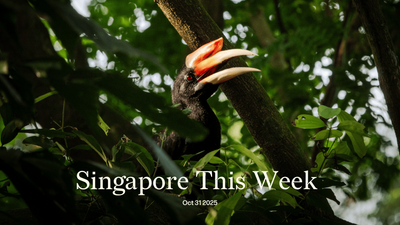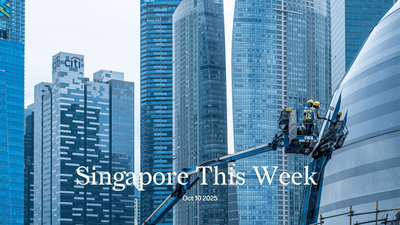Our picks
International: The ballad of Lockheed Martin’s F-35
Singapore will receive four F-35 fighter jets from the US next year. The Republic has ordered 20 in total for more than S$2bn, with the last due in 2030. The F-35s are fifth-generation planes, designed to evade radar, present processed data from varied sensors (older planes provide raw data which pilots must interpret on the fly), and share that data instantly with allied warships and ground forces. For admirers, they are the acme of design innovation, engineering and systems integration; winged warriors in an uncertain world. For critics, they’re emblematic of the worst tendencies of the US military-industrial complex, and the dysfunction of its politics.
Lockheed Martin—the world’s largest weapons manufacturers—began developing F-35s in the late 1990s, at the US government’s behest and the US taxpayer’s expense. Software malfunctions and hardware failures doubled both delivery time and costs, from an initial S$103m per plane to around S$200m in 2010. In 2014, one of the machines caught fire during take-off, costing nearly S$65m; in 2015, the F-35 “performed poorly” in a simulated dogfight against an older plane. An estimate suggested that the 2,500 planes the US has ordered for itself will cost more than S$2trn over the fleet’s 60-year lifespan. (Roughly S$8,000 per US adult, or three times Singapore’s current GDP.) One analyst compared the expenditure to buying a first-class ticket on Singapore Airlines, “anyone’s choice if someone else were footing the bill but…not worth the trade-off for most people most of the time.”
Why US politicians stuck with the F-35 despite monumental delays and gargantuan costs is, fittingly, a marvel of political engineering: “the art of spreading a military project to as many congressional districts [akin to constituencies] as possible, and thus maximizing the number of members of Congress who feel that if they cut off funding, they’d be hurting themselves.” The supply chain of the F-35 was spread over 90 districts (of 435) across the country, spanning states red and blue, and thus supported by politicians neoliberal and socialist. There are many international partners too, including Israel, an avid Lockheed Martin customer and the first foreign buyer of the F-35s. (It has used them in the Gazan genocide, precipitating interrogations globally into the F-35 “supply chain of death”.) Yet, as the US withdrew from Afghanistan in 2021, the firm’s overall outlook was grim; no wars, fewer sales.
Then Russia invaded Ukraine in February 2022. Neighbouring Finland, perhaps sensing Russian moves early, had ordered 64 machines mere weeks before; Greece followed suit with 20; the Czech Republic 24; Romania 32; Germany 35; and Canada 88. The winds of war filled Lockheed’s sails; for Washington, they tied allies into a software ecosystem controlled by a US firm. “It’s as if America and NATO run on iOS, while China and Russia run on Android—and nations must pick one system over the other,” wrote a commentator. A Black Mirror episode waiting to be written.
International: Fear and loathing in Kathmandu
Over the past century, Nepal has been many things: an autocracy; an absolute monarchy, and a constitutional one; a Maoist state, and an elite-dominated democratic one. But it has never been prosperous. Every shift in government—14 since 2008—has promised much and delivered little besides a merry-go-round of mostly corrupt, feckless leaders who’ve feasted amidst wider economic famine. The latest of these was KP Sharma Oli, in his fourth stint as prime minister. Oli was accused of heading an administration steeped in crony capitalism, with politicians amassing vast wealth in a country where one in four live below the poverty line, youth unemployment has touched 20 percent, and more than 2,000 people leave daily in search of opportunities elsewhere. Remittances account for more than 25 percent of the country’s GDP. (Compared, say, to below 10 percent in the Philippines.)
The politicians’ children leave too, posting photos of distant opulence and luxury on their socials. Earlier this month, the government banned 26 social media platforms, ostensibly because of their failure to comply with regulations but widely seen as an attempt to curb criticism of these “nepo babies”, nepo a shorthand for nepotism. Peaceful protests against the ban soon turned into anarchic violence: the Parliament, political party offices, and ministers’ residences, including Oli’s, were torched; some leaders and their families were stripped and thrashed, a few fled by clinging onto ropes dangling from government helicopters. More than 70 were killed in police firing and over 2,000 were injured. The Cabinet resigned, and overnight, the entire state apparatus, president aside, was gone.
Thankfully, fears of an imminent army coup didn’t materialise. Instead, Gen Zs voted for a new leader via a poll on an NGO-managed Discord channel called “Youth against Corruption.” Sushila Karki, former Supreme Court justice, won, with a mandate to restore order and hold proper elections within six months. There’s hope but mostly there’s caution, especially among veteran observers jaded by decades of broken promises and false dawns. The Gen Z movement is a true people’s movement in that it doesn’t have a leader. That’s a strength but a weakness too, leaving the country vulnerable to populists and demagogues. Both the strongest contenders in the upcoming polls, a 50-year-old media personality-turned-politician and a 35-year-old former rapper who’s now the mayor of Kathmandu, have troubling antecedents.
Recent events in Nepal’s neighbourhood will also play on people’s minds. New governments that took over the reins following mass uprisings in Sri Lanka (2022) and Bangladesh (2024) have struggled to enact promised changes; Bangladesh, especially, is in danger of relapsing into the very arms it struggled to free itself from when its interim government holds elections next year. Besides, there’s always the danger of Chinese and Indian meddling as the two behemoths vie for regional influence. Once the sound and the fury dissipates, Nepalis needs calm, collected heads to ensure that their country’s future trajectory is of their own choosing.
Politics: Denial
Four months after the tragedy of October 7th 2023, with over 20,000 Gazans killed, Benjamin Netanyahu claimed that all the foreign leaders he’s spoken with, “deep down in their hearts”, understand that Israel has to crush Hamas and that it has a just cause. But, he said, mimicking them, “we're having problems with public opinion so please help us out.” This admission explains, amongst Israel’s allies, the oh-so-gentle ratcheting up of official “outrage” over the ongoing genocide in Gaza, where the death toll now exceeds 60,000. A diplomatic dance, as Palestinians die. Scepticism is thus warranted with anything the ruling People’s Action Party (PAP) says on the issue. As local opposition to the genocide has grown—Halimah Yaacob, former president, arguably the most influential—so has the government’s apparent dissatisfaction with Israel.
This week, Vivian Balakrishnan, minister for foreign affairs, said that “Israel’s actions in Gaza have gone too far for too long…exacerbated the prolonged, desperate suffering of innocent civilians. This is unconscionable. The scale of civilian death is harrowing…may even be a breach of international humanitarian law.” Singapore reaffirmed its commitment to a two-state solution but said it will only recognise a Palestinian state “when there is an effective government that accepts Israel’s right to exist and categorically renounces terrorism”. The statement ignores how Israeli occupation has long undermined effective Palestinian leadership and fostered conditions ripe for terrorism. Netanhayu’s government is perpetuating the malaise.
Balakrishnan also said that we’ll reconsider our position “if the situation continues to deteriorate or if Israel takes further action to extinguish any prospect for a two-state solution”. But how much further must it deteriorate beyond “unconscionable” and “harrowing”? How much more blood must be spilled? Netanyahu declared two weeks ago that there’ll “be no Palestinian state. This place belongs to us”, when launching Israel’s latest (illegal) West Bank settlement. “How Israel’s West Bank strategy aims to bury Palestinian statehood” is a graphical depiction by Reuters of the very thing Balakrishnan claims to fear. What are we waiting for? In this chicken-and-egg situation, recognition must come first, in keeping with the vast majority of UN member states.
Singapore also announced targeted sanctions on some settler groups. Presumably they won’t include the cabinet’s settler extremists, such as Bezalel Smotrich and Itamar Ben-Gvir (who’ve been sanctioned by others). Pragmatists here will say it’s in our national interest to preserve military ties: Singapore buys weapons from Israel, and just 18 months ago Israeli defence manufacturers hawked their wares at the Singapore Airshow. Perhaps it’s also in our national interest to appease the Zionist business lobby, including Miriam Adelson of the Las Vegas Sands Corp, feted here two months ago as we broke ground on the extension of MBS.
The theatricality and duplicity of global diplomacy are sapping the international system of any remaining legitimacy. Democratic leaders everywhere are being taken for fools by savvy Zionists and their patrons in the White House, eyeing a promised riviera in the promised land. As we sleepwalk towards a one-state solution, what can each individual do in the face of such complex, gargantuan power? This moment demands, at the very least, that we are present, aware, awake to our condition, and not comforted by actions and words designed more to sedate us than to save starving, suffering Gazans. Resist.
Politics: In Parliament
This week’s parliamentary sittings gave us a sense for what politicians will be grappling with over the coming years, including a range of bread-and-butter concerns—job security in the age of AI and automation (see below), cost-of-living stresses, healthcare costs, public housing affordability, public transport reliability (see next blurb). Issues of social and financial import were also tackled: wider safety nets for lower-income families and children from disadvantaged backgrounds; bullying in schools; the great vape clampdown; cybersecurity attacks and hybrid warfare; threats of disinformation and foreign interference; enhanced child- and elderly care; climate change; retirement plans; as well as those relating to Palestinian statehood.
Lawrence Wong, prime minister, reiterated that “no one will be left behind”, explaining how through the usual litany of catchphrases: keep social mobility alive; redouble efforts to maintain a competitive and vibrant economy in a fragmented world; energise Singapore’s enterprise ecosystem; narrow income and wealth inequality: create new and better jobs; strengthen support for the disadvantaged; help Singaporeans retire with dignity; the ‘we-first’ spirit of solidarity; and broaden the definitions of ‘success’. The latter will involve moving beyond “a narrow meritocracy” that’s based solely on grades to a more inclusive one that promotes skills-based hiring, values a diversity of talents, and accords “dignity and respect” to all forms of work. His message might be more effective if the civil service and the PAP themselves hired a more diverse set of people—the party’s new parliamentarians are startlingly similar.
Andre Low, the Workers’ Party new non-constituency MP, acquitted himself well in his maiden speech. He warned that existing social safety nets are “ill-equipped” to cope with the scale of change ahead; said a “permanent foundation of security” was needed; and called for a “profound shift” in how the state thinks about support for the unemployed. Low suggested a “Redundancy Insurance for the AI Age” scheme that would give workers 40 percent of their last-drawn salary, capped at 40 percent of Singapore’s prevailing median income, for up to six months. Even as he welcomed the focus of trust in Tharman Shanmugaratnam’s presidential speech, Low urged a “more courageous” definition of it, one where it becomes a “two-way street”. Hence, one where the government is able to trust its people with information—such as by having a Freedom of Information Act; genuine dialogue as opposed to managed consultation; and “permissive discourse” that celebrates differences in opinion.
Society: Off the rails
After four train disruptions in five days this month, Jeffrey Siow, new PAP MP and acting transport minister, was in the spotlight in Parliament. His 30-odd minute explanation hit some appropriate notes, including his empathy for the welfare of transport workers, the methodical way he addressed numerous questions from colleagues, and his apparent willingness to be transparent with data. But some comments came across as condescending by portraying the Singaporean as ignorant and unrealistic. “Train delays happen in every system, in every city. Our phones, our computers, have to be restarted every now and then. Cars will break down, too. So will our trains.” Illuminating, Jeffrey. “But this is mathematics, this is reality…it’s not possible for us to drive down to zero disruptions.” Understood, Jeffrey.
Jo Teo (@suchabohr), a popular TikToker who’s pursuing her PhD in quantum physics at NYU, rebutted him with one of her now trademark videos blending laid-back, dressed-down, disinterested Gen Z aesthetics with rigorous data and analysis. “No Jeffrey, this is mathematics,” she began. Some of her assertions: Singapore is on “track” for a 20 percent drop in rail reliability from last year to this; the majority of delays this year were over an hour long; if data is extrapolated, we’re projected to lose four million commuter hours this year through delays, which works out to about an S$81m economic cost (based on the hourly wage of Singapore’s median monthly income). Also, questioning the apparent government transparency, Teo notes that the Thomson-East Coast “brown” line is not included in its analysis. “So why is it omitted? I have a guess…a line that has three major breakdowns within a span of like four months would absolutely tank your statistics.”
As interesting as the actual content in the two videos is the contrast in styles: the proprieties of parliamentary discussion versus the accessibility of a person speaking into a microphone latched onto a zucchini. It’s worth watching “JoTeo” just for an insight into the future of political communication and discourse.
Society: Need to get hired fast
Downsizing. Restructuring. Mass layoffs. AI replacing jobs. What support can you get if you’re fired? For lower-income individuals—in households where the monthly per capita income is S$800 or less—ComCare Short-to-Medium-Term Assistance is an option. The scheme offers assistance such as cash for living expenses, payment aids for household and medical bills, employment assistance and referrals to other services. Those who may have exceeded the threshold may still apply, but would need to prove why they are in need of financial support.
Alternatively, individuals who’d earned up to S$5,000 per month can turn to the SkillsFuture Jobseeker Support (JS) scheme. It was implemented in April 2025 to provide up to $6,000 over six months to people who have lost their jobs. But applicants have to hit monthly points targets by participating in various job-seeking activities. About 60 percent of the over 7,200 Singaporeans who’ve applied failed to meet the eligibility criteria, typically because: they weren’t involuntarily unemployed; their past average monthly income exceeded the cap of $5,000; and they had not worked at least six months in the past 12 months.
While it’s worth cheering the introduction of unemployment support in a traditionally welfare-averse society—finally—it’s also important to scrutinise it. Critics and academics have widely problematised the use of means-testing as it does not provide a nuanced perspective of an individual’s financial circumstances. Moreover, the assumption that six months is sufficient to find a job may not be true. Long-term unemployment rate—a period of unemployment that exceeds 25 weeks—has risen to 0.9 in March from 0.8 last year. Some Redditors have also commented on their experiences of long-term unemployment, with some suggesting taking up part-time jobs or moving overseas. Without long-term financial support for the recently retrenched, they are likely to settle in a job that they may not be entirely compatible with. By comparison, retrenched workers in Sweden, at the bare minimum, can receive a fixed payment of SEK 365 (S$50) per day for a maximum period of 300 days, payable on a five-day week basis, and 450 days if the worker has children under 18. It’s a duration that matches the average re-employment rate.
Locally, we have evidence of the benefits of unconditional cash transfers following a trial by AWWA, a social service agency. From May 2022 to October 2023, 75 low-income families received between S$300 and S$550 a month. They did not have to secure employment or meet any other conditions to get the money. The 18-month period was deliberate, as prevailing government programmes offered cash assistance only for three to six months, renewable after. By the end, participants had far lower levels of psychological distress and much better job security than those in the control group. It exemplifies the importance of long-term financial support for those experiencing financial precarity.
Earth: Back to nature
It looks promising on paper, but how does it play out on the ground? In a 2022 commentary, “Carbon Colonialism”, George Monbiot warned: “There is nothing that cannot be corrupted, nothing good that cannot be transformed into something bad. And there is no clearer example than the great climate land grab.” His caution is timely, as Singapore begins to buy carbon credits from nature-based projects. Four initiatives in Ghana, Paraguay and Peru will cost the Republic $76.4m for 2.175m tonnes of carbon credits—equivalent to nearly four percent of our 2022 greenhouse gas emissions. Regionally, Singapore has also signed a carbon-trading pact with Vietnam, following an earlier deal with Thailand. By managing, restoring or protecting living ecosystems like forests and mangroves, CO2 can be removed from the atmosphere, or prevented from being released. These efforts are likely to be central to the country’s 2030 climate targets, with the eventual aim of achieving net zero by 2050.
Advocates of nature-based solutions have called them “win-win strategies”, tackling climate change and biodiversity loss. Yet, Monbiot insisted that they matter only if we “leave fossil fuels in the ground.” Such offsets, however, receive just two percent of all the money used to address climate breakdown, in 2019. “We spend 1,000 times more on fossil fuel subsidies than our natural-based solutions,” Greta Thunberg, climate activist, noted.
There are risks, such as greenwashing and using offsets to excuse emissions that should never occur. To guard against this and ensure the long-term resilience of nature-based projects, experts urge four principles: projects must not replace actual decarbonisation; they should cover diverse ecosystems; support biodiversity; and be co-designed with local communities and Indigenous groups. Success should be measured not only in carbon terms, but also with indicators like species diversity, women’s empowerment, and youth employment.
How Singapore selects and monitors its projects is critical. The National Climate Change Secretariat and the Ministry of Trade and Industry have assured they have vetted projects for “additionality” (that the emissions cuts wouldn’t have occurred without the carbon credits), low leakage risks (the displacement of deforestation, for instance, from one place to another), permanence and co-benefits to surrounding communities. Still, as public funds flow into these ventures citizens must hold its government to account. And remain alert to the inconvenient truths of nature-based schemes that have failed elsewhere.
Arts: Boyz II Lovers
A cheerleader, weary of an overzealous admirer, proposes a fake romantic relationship with a doe-eyed football star. The heir to a crime family, dodging an attack from a rival gang, is swept up by a charismatic bartender who happens to be an underground fighter. But these aren’t your typical bodice-ripping hetero romances. They’re Boys’ Love (BL) novels-turned-dramas that gained stratospheric success first in their home country of Thailand, and then around the world. Saccharine college romance “2gether: The Series” snared its predominantly female audience during the pandemic lockdowns of 2020; the vicious mafia drama “KinnPorsche” went viral two years later. Screaming fans and snaking queues have greeted its stars whenever they arrive in Singapore and, over the past decade, these BL dramas have become some of Thailand’s most lucrative soft-power exports. While these plotlines are unabashedly queer, part of the gender-bending appeal of the genre is that many of these novels, dramas and reams of fanfiction are written by straight women—for straight women. And now, Singapore has its very own BL publishing imprint by way of Giraffe Media, an arm of TrendLit Publishing. It promises original fiction, comics and translations of existing work with a South-east Asian bent, including two Tagalog BL novels now available in English.
Its next two titles, slated for 2026, are both written by 37-year-old Singaporean Beatrix Lowe. The former teacher, whose husband provides feedback on her stories, goes by a pseudonym, as is common in the field—even if the taboo of being a fujoshi (a derogatory pun about being a “rotten” girl) has been somewhat tempered by BL’s global popularity. Point of Information, her debut, is a love story between two male teachers in Singapore. The former childhood sweethearts rekindle their romance when they bring their students to a debate competition. “Some girls like to imagine that they are the female protagonist in the story, but I’m uncomfortable with that,” she told The Straits Times (ST). “Boys’ love allows me to totally remove myself from the story and just enjoy the dynamics.” For other women, BL authorship promises the reclamation of narrative agency. Another writer, 22-year-old student Yolk, complained about typical heterosexual romances to ST: “It’s really irritating because the female characters are always damsels in distress or they are kind of useless.” The “extremely horny” genre, as a cultural studies scholar and pop culture blogger put it, is popular among women for precisely this reason: “...because BL writers implicitly understand how shitty and limiting traditional gender roles are, particularly those imposed on women, who often aren’t at the center of the plot and don’t act with as much agency as male characters (the damsel in distress, girl next door, manic pixie dreamgirl, etc.)” Call it what you will—danmei, yaoi, or slash fanfic—these stories often stress the homosocial, where its protagonists establish an equal partnership, as well as a spiritual bond, and are free to pursue shared goals or rival each other, transforming the male-female gender dynamic that often dominates mainstream narratives. Gay, straight or otherwise, that’s perhaps what we should desire in all our relationships.
Abhishek Mehrotra, Sakinah Safiee, Corrie Tan, Tsen-Waye Tay, and Sudhir Vadaketh wrote this week’s issue.
If you enjoy Jom’s work, do get a paid subscription today to support independent journalism in Singapore.








